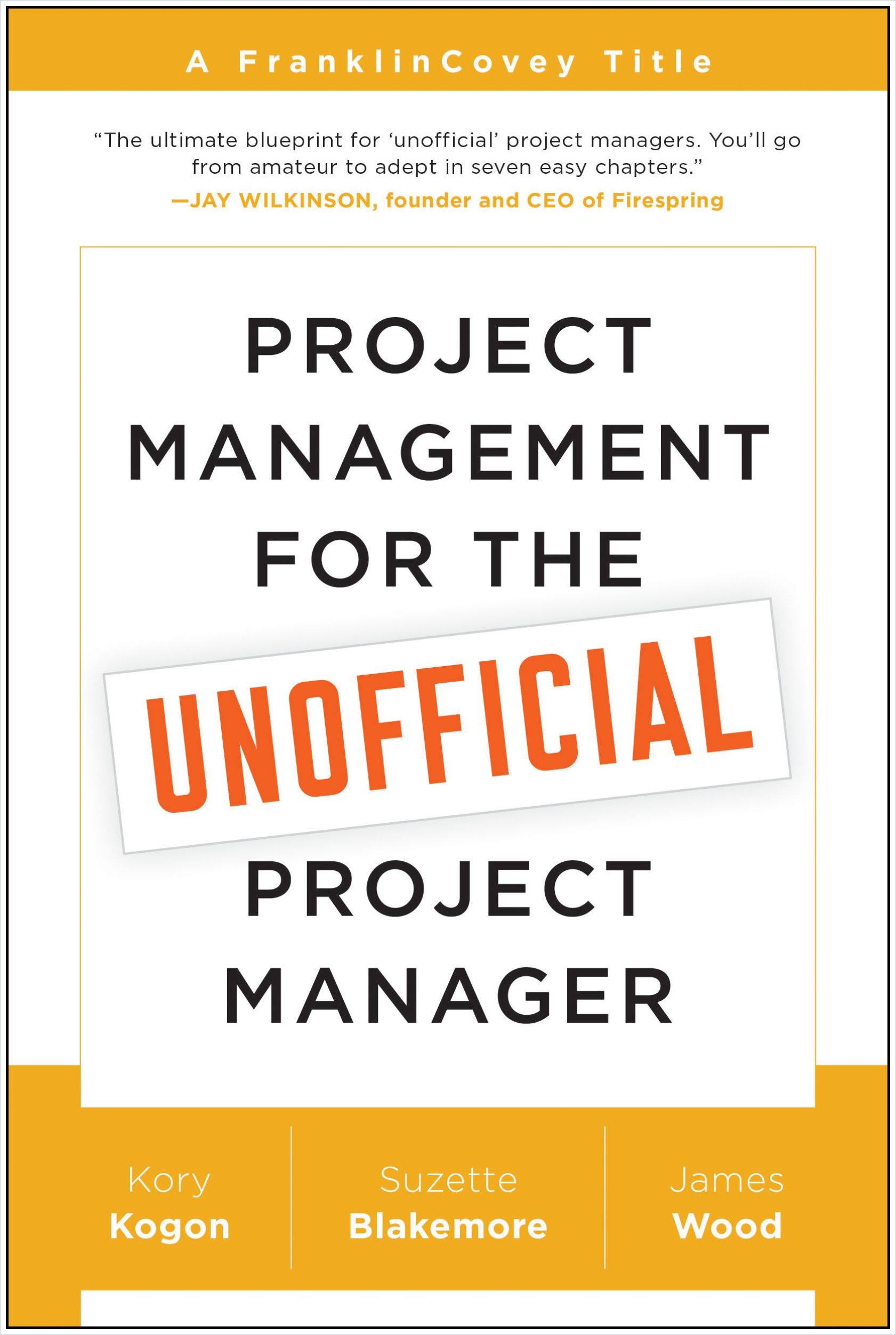If you aren’t a project manager, but find yourself managing projects anyway, a few professional principles can make the difference between success and failure.

Nine Principles for Project Management
Franklin/Covey authors Kory Kogon, Suzette Blakemore, and James Wood share nine crucial project management lessons in their 2015 project management manual designed for those who aren’t official project managers, but end up managing a project nonetheless.
Success requires people and a process
First, they point out that seasoned managers know the success of their projects depends on their people. They urge leaders to internalize a two-part formula for project management success: “People plus process equals success.” Whether they are conducting stakeholder interviews at the start of a project or holding people accountable once the work is in motion, successful project managers show their appreciation by treating people well.
Respect your team members, listen to them, clarify the steps to completing the project, and hold yourself and others accountable. Follow the “process groups,” or stages, that make up a project: Initiate, plan, execute, monitor, control, and close. These phases sound straightforward, but the devil is in the details. The authors cautiously advise that the project management road is seldom straight. As you work through these steps, expect to have to go back and adjust your plan.
As we research productivity in the 21st century workplace, we realize that the methods and systems that ‘official’ project managers use can fill an enormous skills gap for what has become the unofficial project management workforce – basically the vast majority of knowledge workers. Kory Kogan, Suzette Blakemore, James Wood
The authors’ second principle is to scope out the entire project before you begin. Resist the powerful temptation to jump right into the “doing” part of the project, especially when your assignment seems pretty clear. A better way to initiate your project, the authors warn, is to start with “key stakeholder interviews” – a common practice in management consulting. Get as much information upfront as possible from the people who have an interest – whether loose or invested – in your project’s work.
Ask stakeholders for their “desired results”: Are they looking for outcomes that are good, fast, or cheap? Tell them that achieving all three is often difficult, but two out of the three might be feasible. Having been down this road often, the authors advise asking at the very beginning for any relevant stakeholder concerns outside the project’s scope. Summarize everything you learn in these interviews in your “project scope statement” – a document that others will refer to as the “project charter.” The completed, signed-off project scope document is your starting point. Now you may proceed.
“Anything that can go wrong, will.”
Kogon, Blakemore, and Wood explain how to avoid as many pitfalls as possible by following their third principle: manage risk. They make it clear that project managers – official or unofficial – must invest time in project planning before they execute. The planning process starts with assessing your risks based on their “probability” and “impact.” Your goal is to “T.A.M.E.” each risk by applying this acronym: Can you “Transfer” the risk, “Accept” the risk and deal with it if it materializes, “Mitigate” the risk, or “Eliminate” it? You must deal with your project’s looming risks. Just as you would not let a lion run around untamed, tame your risks by creating a “risk management plan.”
According to the Project Management Institute, a failed project costs an additional one-third of the original budget…and there are greater costs than just the budget. What about lost opportunities? Dissatisfied customers? Loss of innovation? And most damaging, diminished employee engagement and morale?Kogan, Blakemore, Wood
As the authors introduce their “Work Breakdown Structure” (WBS) and “Finish-to-Start,” “Start-to-Start,” or “Finish-to-Finish” activities, the manual becomes more technical. These terms might sound daunting to a project management novice. Happily, the accessible illustrations help you get the idea. One clear example: Thawing a turkey completely before putting it in the oven is a finish-to-start activity. The next step is to identify the project team’s resources and estimate each task’s duration.
The authors’ fourth principle is a warning: Don’t equate work – the time a task takes – with duration, the time needed to get the task done. For example, it might take your co-worker only 10 minutes to draft and send an email. However, since she has a lot of other things to do, the duration might be four hours. She might not even open her email inbox until lunch. Be realistic about timing. Estimate the duration of each task, “accounting for everything else that needs to get done as well – real life.”
Heed sequencing and accountability
Senior managers who want to challenge your project management knowledge, especially if you are managing a project unofficially, will ask about your project’s “critical path.” This term describes the sequence of activities that define how long the project will take from start to finish, identifying the most time-consuming series of planned steps during which every task must start and end as scheduled. Following your critical path is the book’s fifth principle because a delay in one task on the critical path means the entire project schedule must shift.
Kogon, Blakemore, and Wood suggest paying close attention to each project’s critical path and proactively managing potential bottlenecks to stay on track. This valuable nugget of advice can make you look good and spare you future headaches.
Nothing destroys trust faster than making and breaking a promise. Conversely, nothing builds trust more than keeping a promise.Stephen R. Covey
Accountability encompasses being responsible for your actions and holding others accountable for theirs – and that’s the authors’ sixth principle. To create “team accountability,” set up regular meetings, perhaps weekly, with a strict agenda. Start by giving an overview of where the project stands. Then ask everyone to report on last week’s commitments. When roadblocks occur, offer to help “clear the path.” Keep the project in motion by asking team members for new commitments. Record and share their promises and follow up during team accountability sessions.
Communicate and “control scope creep.”
Given the authors’ years of project management experience, they know how difficult it is to keep a project on track. Their seventh principle suggests keeping tabs on the project by using a “project status report” – a one-page update to communicate progress and get help from your stakeholders. Clearly state any problems, using attention-getting, news-style headlines. The authors emphasize that these status reports aren’t just crisis tools. Use them regularly to engage your main stakeholders and keep your project on their radar. If you need support, this gives you better access to those who control the project’s resources.
Many project managers dread so-called scope creep, the “tendency of a project to change and grow into an uncontrollable monster.” In their eighth principle, Kogon, Blakemore, and Wood urge you to use “project change request” forms for any major changes. Some project changes may benefit you – the risky part is when the project’s scope changes without you being aware of it. The authors share an important insight: The accumulation of small changes can have a significant impact on your project’s resources, risks, and other constraints. Using change request forms helps you record these changes. That’s an asset when you’re monitoring, controlling or reporting on your project’s progress.
Document what this experience taught you.
Kogon, Blakemore, and Wood suggest following a “closing process” that includes a checklist and possibly a celebration. Your project isn’t finished until your task list is down to zero, you’ve received project scope fulfillment check-offs from all stakeholders, and you’ve made a list of lessons learned. The authors note that people like personal thank-you notes – an easy-to-apply insight that can make a big difference, costs little, and puts you in good stead for next time. Holding a celebratory meeting complete with good food is totally appropriate. People will enjoy getting together for fun after having worked together, and you never know when you’ll need them again.
A lot of us have quietly slipped into [project management]…and we’re fighting project failure every day as we try to push through to a deadline, save a budget, or keep people (or ourselves) from messing everything up.Kogan, Blakemore, Wood
This well-regarded manual was published in 2015, and Kogon and Blakemore now offer a 2024 update that guides readers through the “scope, plan, engage, track and adapt, and close” process. The authors are from Franklin/Covey, where Kory Kogon is a Global Practice Leader for Productivity, Suzette Blakemore is a Regional Productivity Practice leader, and James Wood is a coach and senior leadership consultant.











